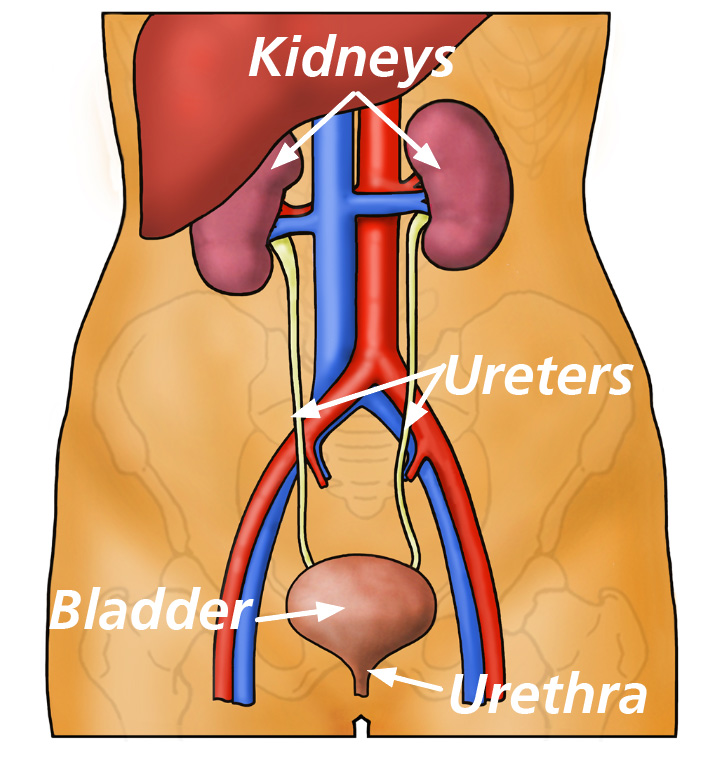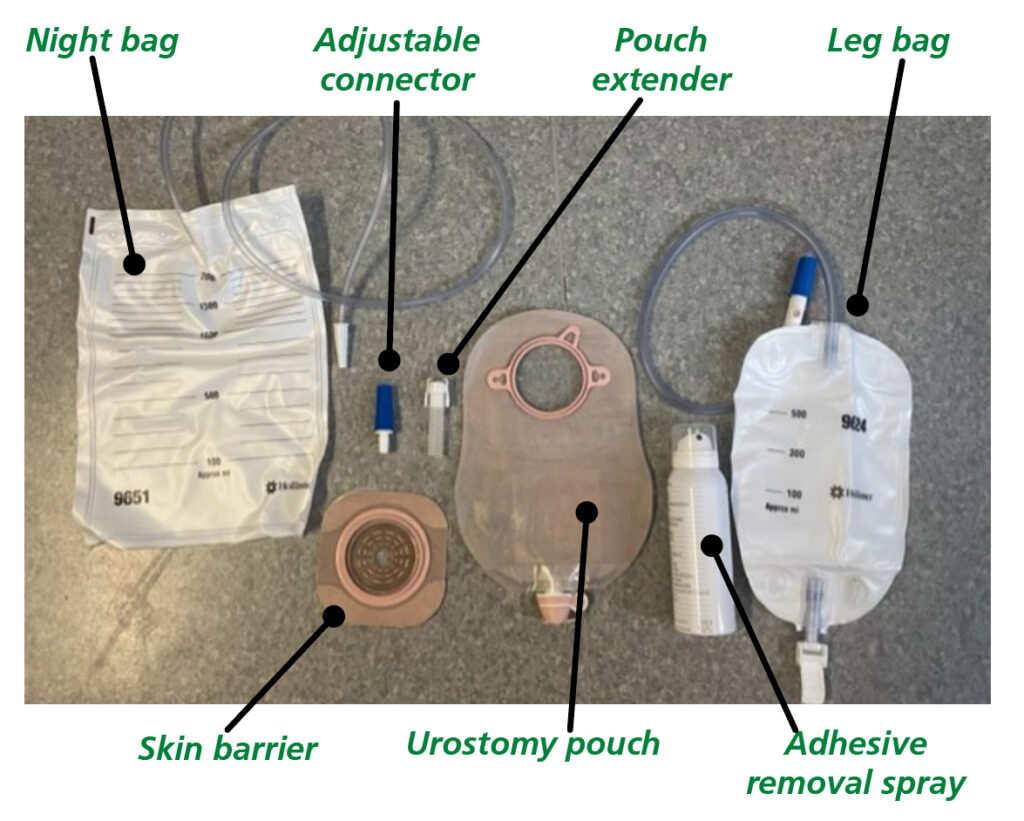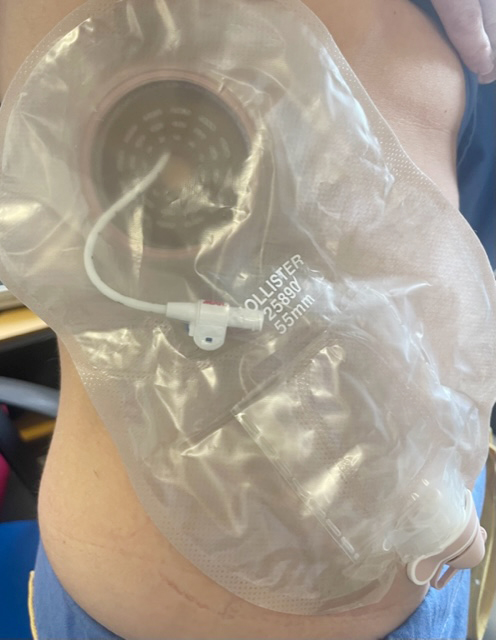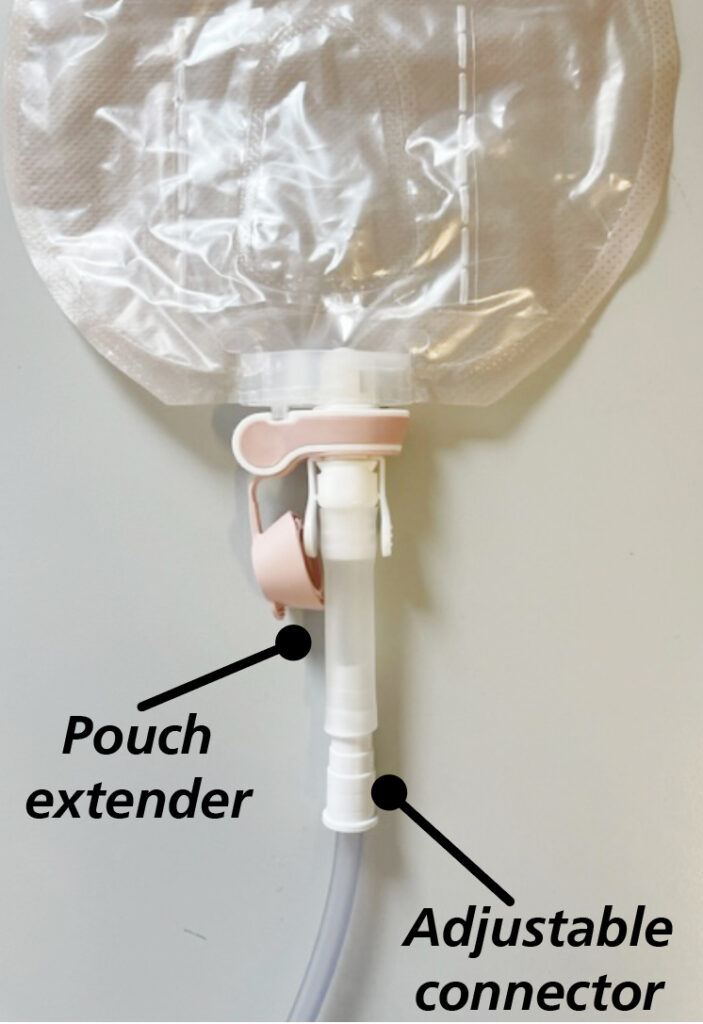The Nephrostomy passport and catheter exchange records can be accessed via the action link above.
The Urinary System
The urinary system is comprised of the kidneys, ureters, bladder and the urethra. The kidneys are located at the back of the body and filter blood to remove waste products, which produces urine. Urine flows from the kidneys through a tube called a ureter, down to the bladder where it is stored until you are ready to pass urine. It leaves the bladder through a tube called the urethra.

What is a nephrostomy?
A nephrostomy is a thin, plastic tube that is placed directly into your kidney through your back, allowing urine to drain out. The urine drains through the nephrostomy into a urostomy pouch.
Why is a nephrostomy needed?
A nephrostomy tube is needed when the ureter becomes blocked, stopping urine from flowing from the kidney to the bladder. The most common causes of a blockage are stones, strictures (narrowing) or cancer growth.
How long can the nephrostomy stay in for?
The length of time will depend on your individual situation. The nephrostomy will be removed if treatment can remove the blockage in your ureter, for example with a stent.
A stent is a small plastic tube that is placed in your ureter.
Some patients are not suitable to have a stent or treatment, and in these cases the nephrostomy may be permanent, needing to be changed periodically – this is usually every 12 weeks.
Follow up appointments or further treatment
Nephrostomies are usually a temporary measure but can be more long term if your doctor decides it is needed.
If your nephrostomy is to stay in for a prolonged period then you will have a follow up appointment booked to have your tube changed. This will be in the Bexley Wing Radiology Department approximately 12 weeks after the original insertion. This is to prevent a blockage and to reduce infection risk.
Supplies for your nephrostomy

Caring for your nephrostomy
Your urostomy pouch comes in two parts: the skin barrier and the pouch. The skin barrier sticks directly to your skin, with the nephrostomy tube coming through the hole in the middle. This should be changed roughly once a week or more frequently if needed.
The urostomy pouch clicks on to the skin barrier and this is where the urine will be collected. This pouch should be changed as and when needed.
Changing your urostomy pouch

- Always ensure you wash and dry your hands thoroughly before touching the pouch.
- Carefully unclip the urostomy pouch from the skin barrier and dispose of it.
- Spray the edges of the skin barrier with the adhesive removal spray to loosen it from your skin.
- Pull the barrier from your skin, making sure not to pull the nephrostomy tube.
- Clean the skin area around the nephrostomy site with warm water and gauze.
- Ensure the skin is fully dry before reapplying the new skin barrier.
- Peel the backing off the skin barrier and feed your nephrostomy through the central hole. Push firmly to your skin.
- Clip the new urostomy pouch to the skin barrier, ensuring you feed the nephrostomy into the pouch with it pointing down. Do not force the nephrostomy tube to the bottom of the bag – it is designed to sit at the top and drain into the lower chambers. Angling the urostomy pouch towards the front of the body can help when emptying.
Emptying your nephrostomy pouch
- Open the drip tap at the bottom of your pouch and drain it into a clean, dry container and discard the urine down the toilet.
- Close the drip tap after you have drained the pouch and wipe any urine from the end of the tap with a clean tissue.
- Wash and dry your hands again.
Connecting your leg bag or night bag

- Wash and dry your hands thoroughly.
- Connect the pouch extender to the leg or night bag.
- Attach the leg/night bag to the bottom of the urostomy pouch. If using a leg bag, ensure that the tap is closed.
- Once both are connected, open the urostomy pouch tap and leave it in an open position while the leg/night bag is attached.
- When no longer required, close the tap on the urostomy pouch, remove the leg/night bag and dispose of it.
- The leg bag has a long tube which can be adjusted by cutting it to a length that suits you. The adjustable connector can then be attached to the bag extender.
Coping at home
Once at home, you can return to your normal day to day activities, ensuring the points below are followed:
- Always wash your hands before changing your pouch or skin barrier.
- Empty the urostomy pouch when it is half full to avoid it becoming too heavy, potentially pulling it away from your skin.
- Aim to drink at least two litres (four pints) of fluid per day to help reduce the risk of infection.
- You can shower 48 hours after the tube has been inserted but you must keep the entry site dry.
Initially, dressing and bag changes will be carried out by a District Nurse. As you or a family member become more confident, you may wish to care for it yourself.
District Nurses
Before you are discharged, an appointment with the District Nurse will have been arranged. They will ensure your skin barrier and urostomy pouch is changed regularly.
Nephrostomy Supplies
Fittleworth are the company that will supply you with the equipment you need to care for your nephrostomy. The Fittleworth referral will be made on the ward before you are discharged and you should expect delivery within two working days.
Your GP will receive a prescription request for the equipment supplied by Fittleworth, which covers 10 changes. You will then be required to order your next set of supplies using the product codes below.
| Item description | Code | Quantity |
| Hollister ceraplus skin barrier | 15500 | 2 boxes (10 items) |
| Hollister urostomy pouch | 25890 | 1 boxes (10 items) |
| Hollister cera ring | 8805 | 1 boxes (10 items) |
| Hollister adapt adhesive remover spray | 7731 | 1 can (100 mls) |
| Hollister night bag | 5550 | 1 box (10 items) |
| Night tube adaptor | 7331 | 1 boxes (10 items) |
| Hollister variable length leg bag 500 mls | 9624 | 1 boxes (10 items) |
| Libra leg bag strap | 10637t | 1 pack ( 5 pairs) |
If you have any problems with the deliveries, please contact Fittleworth:
Contact us
Please contact the Bexley Wing Radiology Department, Monday to Friday, 8am-5pm, if you experience any of the symptoms of a dislodged or blocked nephrostomy tube.
NHS 111
This service offers medical help and advice from fully trained advisors supported by experienced nurses and paramedics. Available over the phone 24hours a day.